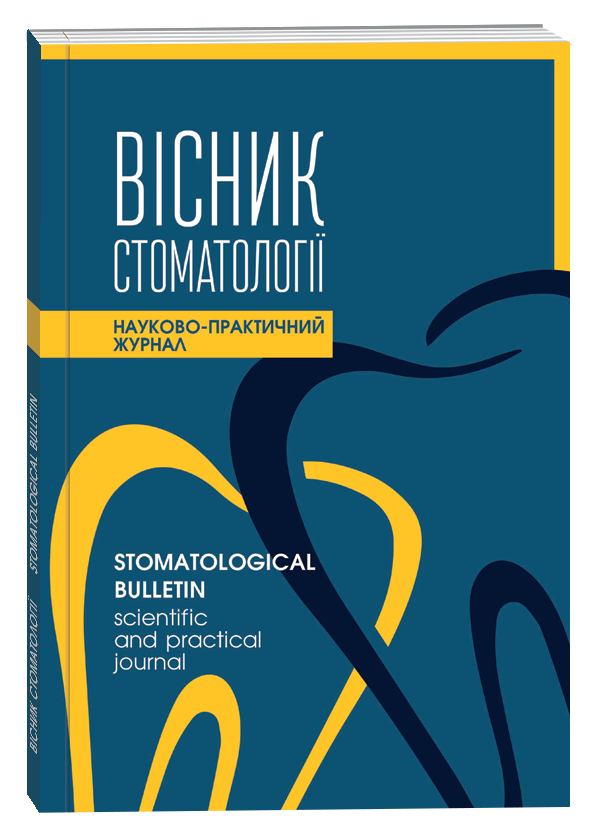ВПЛИВ РІЗНИХ ВИДІВ ВІРУСІВ НА ПУХЛИНОГЕНЕЗ. ОГЛЯД ЛІТЕРАТУРИ
DOI:
https://doi.org/10.35220/2078-8916-2019-34-4-61-67Ключові слова:
онковіруси, пухлини слинних залоз, ВПЛ, ЕБВ, синергізм вірусної інфекціїАнотація
Вступ. На сьогоднішній день відомо багато видів рі-зноманітних вірусних агентів, які впливають на пух-линогенез – ВПЛ, EБВ, ВГБ, ВГС, Саркоми Капоши вірус, екзогенний ретровірус, та інші. Серед діагнос-тичних методів визначення вірусних агентів виділя-ють ПЛР (полімеразна ланцюгова реакція) та імуно-гістохімічне дослідження. Втім, не дивлячись на зна-чну кількість наукових досліджень з приводу впливу вірусної інфекції на пухлиногенез, робіт присвячених системному огляду цієї проблематики – незначна кі-лькість.
Мета дослідження. Вивчення впливу різних груп віру-сів на пухлиногенез на основі огляду літератури.
Результати дослідження. Проведений аналіз біль-шості літературних джерел показав наявність ви-раженого синергізму між окремими видами вірусу. При цьому розвиток пухлин слинних залоз є типовим прикладом пухлиногенезу за участю вірусної інфекції, зокрема ВПЛ та EБВ.
Висновок. Описані види вірусів мають 3 види впливу на пухлиногенез - індукція генетичної нестабільності, відтворення мікрооточення пухлини, зміни в клітин-ному фенотипі.
Посилання
Morris MA, Young LS, Dawson CW. DNA tumour viruses promote tumour cell invasion and metastasis by deregulating the normal processes of cell adhesion and motility. Eur. J. Cell Biol. 2008; 87: 677–697.
Schottenfeld D, Beebe-Dimmer J. The cancer burden attributable to biologic agents. Ann. Epidemiol. 2015; 25: 183–187.
Oh JK, Weiderpass E. Infection and cancer: global dis-tribution and burden of diseases. Ann. Glob. Health. 2014; 80: 384– 392.
Moerman-Herzog A, Nakagawa M. Early defensive mechanisms against human papillomavirus infection. Clinical and Vaccine Immunology. 2015; 22(8):850–857.
Boda D, Neagu M, Constantin C et al. HPV strain dis-tribution in patients with genital warts in a female population sample. Oncology Letters. 2016;12(3):1779–1782.
Yasmeen A, Bismar TA, Kandouz M et al. E6/E7 of HPV type 16 promotes cell invasion and metastasis of human breast cancer cells. Cell Cycle. 2007; 6:2038–42..
Al Moustafa AE, Al-Antary N, Aboulkassim T et al. Co-prevalence of Epstein-Barr virus and high-risk human papil-lomaviruses in Syrian women with breast cancer. Hum Vaccin Immunother. 2016;12:1936–9. .
De Marco F. Oxidative stress and HPV carcinogenesis. Viruses. 2013;5(2): 708–731.
Kemp TJ, Hildesheim A, Garcia-Pineres A et al. Ele-vated systemic levels of inflammatory cytokines in older women with persistent cervical human papillomavirus infection. Cancer Epidemiology Biomarkers & Prevention. 2010;19(8):1954–1959. .
Kulkarni S, Rader JS, Zhang F et al. Cyclooxygen-ase-2 is overexpressed in human cervical cancer. Clinical Can-cer Research. 2001; 7(2):429–434.
Hiraku Y, Tabata T, Ma N et al. Nitrative and oxida-tive DNA damage in cervical intraepithelial neoplasia associated with human papilloma virus infection. Cancer Science. 2007; 98(7):964–972.
Okuno Y, Murata T, Sato Y. Publisher Correction: Defective Epstein-Barr virus in chronic active infection and haematological malignancy. Nat Microbiol. 2019;4(3):544.
Niller HH, Szenthe K, Minarovits J. Epstein–Barr virus–host cell interactions: an epigenetic dialog? Front. Genet. 2014; 5: 367.
Morscio J, Dierickx D, Tousseyn T. Molecular pathogenesis of B-cell posttransplant lymphoproliferative disorder: what do we know so far? Clin Dev Immunol.2013, 2013:150835.
Moghoofei M, Mostafaei S, Nesaei A. Epstein–Barr virus and thyroid cancer: The role of viral expressed proteins. J Cell Physiol. 2019; 234(4):3790-3799.
Lawson JS, Salmons B, Glenn WK. Oncogenic Vi-ruses and Breast Cancer: Mouse Mammary Tumor Virus (MMTV), Bovine Leukemia Virus (BLV), Human Papilloma Virus (HPV), and Epstein–Barr Virus (EBV). Front. Oncol. 2018; 8:1.
Müller-Coan BG, Caetano BFR, Pagano JS. Cancer Progression Goes Viral: The Role of Oncoviruses in Aggres-siveness of Malignancies. Trends in Cancer. 2018; 4(7):485-498.
Neuveut C, Wei Y, Buendia M A. Mechanisms of HBV-related hepatocarcinogenesis. J Hepatol. 2010; 52: 594-604.
Vincendeau M, Göttesdorfer I, Schreml JM et al. Modulation of human endogenous retrovirus (HERV) transcrip-tion during persistent and de novo HIV-1 infection. Retrovirology. 2015; 12: 27.
Höpken M, Förster I, Maune S et al. Association of the Human Bocavirus With Tonsil Squamous Cell Carcinomas. Front. Microbiol. 2018; 9:2450.
Chen J, Foroozesh M, Qin Z. Transactivation of hu-man endogenous retroviruses by tumor viruses and their func-tions in virus-associated malignancies. . Oncogenesis. 2019; 8:6.
Dalpa E, Gourvas V, Baritaki S et al. High preva-lence of human herpes virus 8 (HHV-8) in patients with Warthin’s tumors of the salivary gland. Journal of Clinical Vi-rology. 2008;42(2):182–185.
Syrjänen K, Syrjänen S, Lamberg M et al. Morpho-logical and immunohistochemical evidence suggesting human papillomavirus (HPV) involvement in oral squamous cell car-cinogenesis. Int J Oral Maxillofac Surg. 1983;12:418–24.
Mehanna H, Beech T, Nicholson T et al. Prevalence of Human Papillomavirus in oropharyngeal and non-oropharyngeal head and neck cancer – systematic review and meta-analysis of trends by time and region. Head Neck. 2013;35:747–55.
Vageli D, Sourvinos G, Ioannou M et al. High-risk human papillomavirus (HPV) in parotid lesions. Int J Biol Markers 2007;22:239–44.
Skalova A, Kapırkova J, Andrle P et al. Human papil-lomaviruses are not involved in the etiopathogenesis of salivary gland tumors. Czecho-Slovak Pathology. 2013; 49(2):72–75.
Isayeva T, Said-Al-Naief N, Ren Z et al. Salivary mucoepidermoid carcinoma: demonstration of transcriptionally active human papillomavirus 16/18. Head and Neck Pathology. 2013; 7(2):135– 148.
Descamps G, Duray A, Rodriguez A et al. Detection and quantification of human papillomavirus in benign and ma-lignant parotid lesions. Anticancer Res 2012;32:3929–32.
Brunner M, Koperek O, Wrba F et al. HPV infec-tion and p16 expression in carcinomas of the minor salivary glands. Eur Arch Otorhinolaryngol 2012;269:2265–9.
Hafed L, Farag H, Shaker O et al. Is human papillo-ma virus associated with salivary gland neoplasms? An in situhybridization study. Arch Oral Biol 2012;57:1194–9.
Anderson CE, McLaren KM, Rae F et al. Human papilloma virus in squamous carcinoma of the head and neck: a study of cases in south east Scotland. J Clin Pathol 2007;60:439–41.
Santucci M, Gallo O, Calzolari A. Detection of Ep-stein-Barr viral genome in tumor cells of Warthins tumor of pa-rotid glands. AJCP 1993; 100: 662-665.
Klussmann JP, Muller A, Wagner M et al. Human herpesvirus type 8 in salivary gland tumors. Journal of Clinical Virology. 2000;16(3):239–246.









